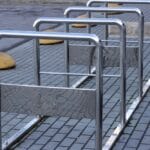Why Cleaning Galvanized Steel Is Essential
Regularly cleaning galvanized steel is essential for maintaining its properties and durability. Proper upkeep helps preserve the quality of galvanized sheet metal or any other galvanized surface, ensuring both effective protection and a neat, attractive appearance. Here’s why this task should not be overlooked.
Protecting the Galvanized Surface
Routine maintenance prevents corrosion by keeping the zinc coating intact. This coating acts as a protective barrier against moisture, salt deposits, pollution, and other external elements that could damage galvanized metal and shorten its lifespan.
Preserving the Shine
With the right cleaning methods, galvanized steel can maintain its brightness and look like new. This is especially important for visible or decorative surfaces, such as exposed sheets or outdoor metal structures.
Removing Impurities
Dirt, dust, mineral deposits, and other residues can accumulate over time, affecting not only the appearance but also the strength of the metal. Careful cleaning with appropriate tools and products removes these impurities without damaging the zinc coating or weakening the structure.
Equipment Needed for Cleaning Galvanized Steel
Essential Tools
-
Soft cloth or non-abrasive sponge: Cleans the surface gently without scratching.
-
Nylon brush: Ideal for reaching difficult areas and removing embedded dirt.
-
Bucket and protective gloves: Ensures safe handling and protects hands when using cleaning products.
Recommended Products
-
Warm water and mild soap: A simple yet effective solution for cleaning galvanized metal without damaging the protective coating.
-
Diluted white vinegar: Effective for removing stubborn stains without using harsh chemicals.
-
Baking soda: Useful for tackling persistent deposits and restoring shine to galvanized sheet metal.
Specific Precautions
-
Avoid abrasive products, metal brushes, or unsuitable acidic cleaners, as these can damage the zinc coating.
-
For paint residue, use a plastic scraper or a cloth soaked in soapy water to avoid damaging the surface.
-
Always rinse thoroughly to remove all traces of cleaning products.
Summary Table: Tools, Products, and Uses
| Type | Example | Use |
|---|---|---|
| Tools | Soft cloth, sponge, nylon brush | General cleaning and hard-to-reach areas |
| Products | Warm water + mild soap | Routine maintenance |
| Specialty Products | Diluted white vinegar | Stubborn stains, white oxidation |
| Gentle Abrasives | Baking soda | Persistent deposits |
| Protection | Gloves, bucket | Safety and comfort during work |
Step-by-Step: How to Clean Galvanized Steel
1. Surface Preparation
Before starting, make sure the galvanized steel surface is free of dust and debris. Remove loose dirt with a dry cloth or soft brush, then prepare a bucket with warm water and mild soap. This solution works for most galvanized sheets and surfaces.
2. Basic Cleaning
Soak a soft sponge or non-abrasive cloth in the soapy water and clean the surface using circular motions. This helps remove dirt and residues while protecting the coating. For tougher or dirtier areas, use a nylon brush.
3. Treating Specific Stains
For tougher stains such as white rust or persistent deposits, apply a diluted white vinegar solution (1 part vinegar to 10 parts water). Gently scrub with a nylon brush or cloth, then rinse immediately with clean water to avoid leaving acidic residue.
4. Rinsing and Drying
Rinse the entire surface thoroughly with clean water to remove all traces of soap or vinegar. Dry with a clean, lint-free cloth to prevent water spots and restore shine.
Tips to Maintain the Shine of Galvanized Steel
-
Cleaning frequency: Clean exposed surfaces, such as galvanized sheets or outdoor structures, at least once a year.
-
Proper storage: Store galvanized items in a dry, well-ventilated area to prevent oxidation.
-
Extra protection: Apply a protective coating or wax to extend the life of the zinc coating and improve resistance to chemicals and moisture.
Key Summary
-
Regular cleaning preserves the durability, shine, and protective properties of galvanized steel.
-
Only use gentle tools and suitable products, such as mild soap, diluted vinegar, or baking soda.
-
Avoid abrasive or harsh chemical cleaners.
-
Always dry thoroughly after washing to prevent water marks and oxidation.
-
Maintain at least once a year, or more often for highly exposed surfaces.
FAQ
How do you remove rust from galvanized metal?
Use a soft brush to gently remove rust without damaging the galvanization. Then apply a diluted white vinegar solution, rinse with clean water, and dry thoroughly. This works for sheet metal as well as items such as trailers or galvanized structures.
How do you restore galvanized steel to look new?
Clean thoroughly with warm water and mild soap. For stains, use baking soda or diluted vinegar. After rinsing and drying, applying a light protective layer can help maintain the shine.
How do you remove white oxidation from galvanized metal?
Mix diluted white vinegar (1:10) with water, gently scrub the affected area with a cloth or soft brush, then rinse thoroughly. Dry immediately to prevent oxidation from returning.
How do you clean galvanized steel?
For regular cleaning, use a soft cloth or sponge with warm water and mild soap. Gently scrub, rinse, and dry. This is enough to remove most dirt while protecting the coating.
How do you deep-clean galvanized steel?
Start with basic washing, then treat problem areas with diluted vinegar or baking soda. Use a nylon brush for more stubborn deposits, rinse thoroughly, and dry.

